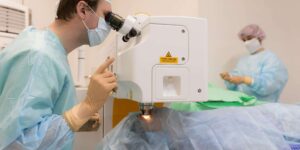
Blepharoplasty can help your eyes look younger
Gorgeous new handbag: hot. Pesky bags under your eyes: not so much.
what is cataract surgery
While numerous creams have been touted as cure-all potions to help firm and tighten the damage that aging, allergies, and just bad genes can wreak on a youthful pair of peepers, putting a permanent end to these nuisances might actually be too difficult for the powers of many over-the-counter remedies. Blepharoplasty, or eyelid reshaping, involves removing the excess fat and skin around the upper and lower eyelids and tightening the surrounding muscles to create a smoother, more youthful appearance. Each year nearly 100,000 people opt for blepharoplasty. Remember, It’s not done by a cataract eye surgeon, cataract eye surgery is very different from blepharoplasty, which many people believe Blepharoplasty is done by the cataract eye surgeon, there is a special Blepharoplasty surgeon who performs this surgery, you have to search the best surgeon in your area.
While men and women of all ages may consider blepharoplasty, Dr. Gregory Buford, a board-certified plastic surgeon in Denver who specializes in facial restoration, says that oftentimes those who come in before too much damage has occurred may fare better than those who wait. This is true because typically more youthful skin has less damage and is in better overall condition to handle and recover from the procedure.
Blepharoplasty may be performed on either the upper or lower eyelid. While surgery performed on the lower eyelid is typically for cosmetic reasons only, upper eyelid blepharoplasty may be needed for more than just aesthetic purposes alone. Some people suffer from such sagging in the upper eyelid area that the excess skin covers a portion of the eye and impairs vision, which can cause difficulty in day-to-day life with such activities as reading, working, and driving.
When conducted for medical reasons, insurance may cover the procedure. However, as with most plastic surgery procedures, when done for a cosmetic reason alone you’ll be forking out approximately $5,000-$6,000 of your own hard-earned dollars. If this sounds like a lot to you, consider how much you spend on over-the-counter products each year and then add that up over the course of your lifetime: You just might find blepharoplasty winds up to be cheaper in the long run.
Am I a Candidate for Blepharoplasty?
Blepharoplasty involves the area surrounding the eye; therefore, those with certain ocular ailments such as glaucoma or a detached retina will need to speak with a surgeon to determine if the surgery is a good fit for them. Also, as with all surgeries, those who smoke, people with thyroid disease, and anyone suffering from high blood pressure must first be cleared by a surgeon before undergoing the procedure. In regards to downtime, make sure you can take at least a few days off to rest and recover, and that if you do have to return to work before a week is up you’ll be able to do so with a possible shiner and not get penalized for the look.
The Surgical Procedure
When blepharoplasty is performed on the upper lid, the surgeon will make a fine incision in the natural crease of the lid slightly above the lash line and then another incision above the first. This creates an opening in which the excess skin and a small strip of muscle can be removed. Excess fat may be contoured, creating a smoother appearance, and the upper lid muscle will be tightened. Once finished, the surgeon will close the incision areas with sutures; these will then be removed within days.
For the lower lids, an incision is made just below the natural lower lid lash line. Fat pads are then removed or contoured and the excess skin and muscle are tightened. Absorbable sutures are then used to close the incision; invisible to the eye, these will dissolve on their own.
In both cases, your surgeon may use topical anesthesia to numb the area or may rely on an anesthesiologist to prescribe something that will make you a bit drowsy during the surgery. Each procedure lasts about one to one and a half hours and is performed under general anesthesia.
Recovery
While you may want to show off those new and improved baby blues (or browns or greens) immediately following surgery, it’s best to plan for a week or so of downtime before filling up your little black book. For the first few days, you may find yourself tearing up as often as you did when you lost your first true love, and your vision might remain blurry for a while post-op thanks to the ointment used to protect your new peepers. Your eyes may also remain dry for a while. Don’t worry, as these are all common and completely normal conditions following this type of surgery. But if your vision remains blurred for longer than a few days or if you experience a total loss of vision or excessive bleeding, get to the doctor immediately.
Dr. Buford says that most clients will experience mild bruising around the eye area for about one week and minimal swelling for up to 10 days; these can be diminished by applying gel pads or frozen peas to the area for the first 48 hours following surgery. Women can begin applying makeup to the area once sutures have been removed, which is generally around five days post-surgery; this is particularly nice for those that are still experiencing some residual bruising and swelling around the eye area. Blepharoplasty also offers a great excuse for purchasing a new pair of shades, as you will want to both hide your eyes and protect them from the elements following the procedure.
Risks
Risks of the procedure can include excess bleeding, asymmetry, and the need for revisional surgery at some point in the future. Major risks, which though uncommon are possible, include blindness and uncontrolled bleeding. Says Dr. Buford, “Thankfully, these risks are extremely rare when the procedure is performed by a skilled and knowledgeable plastic surgeon.”




